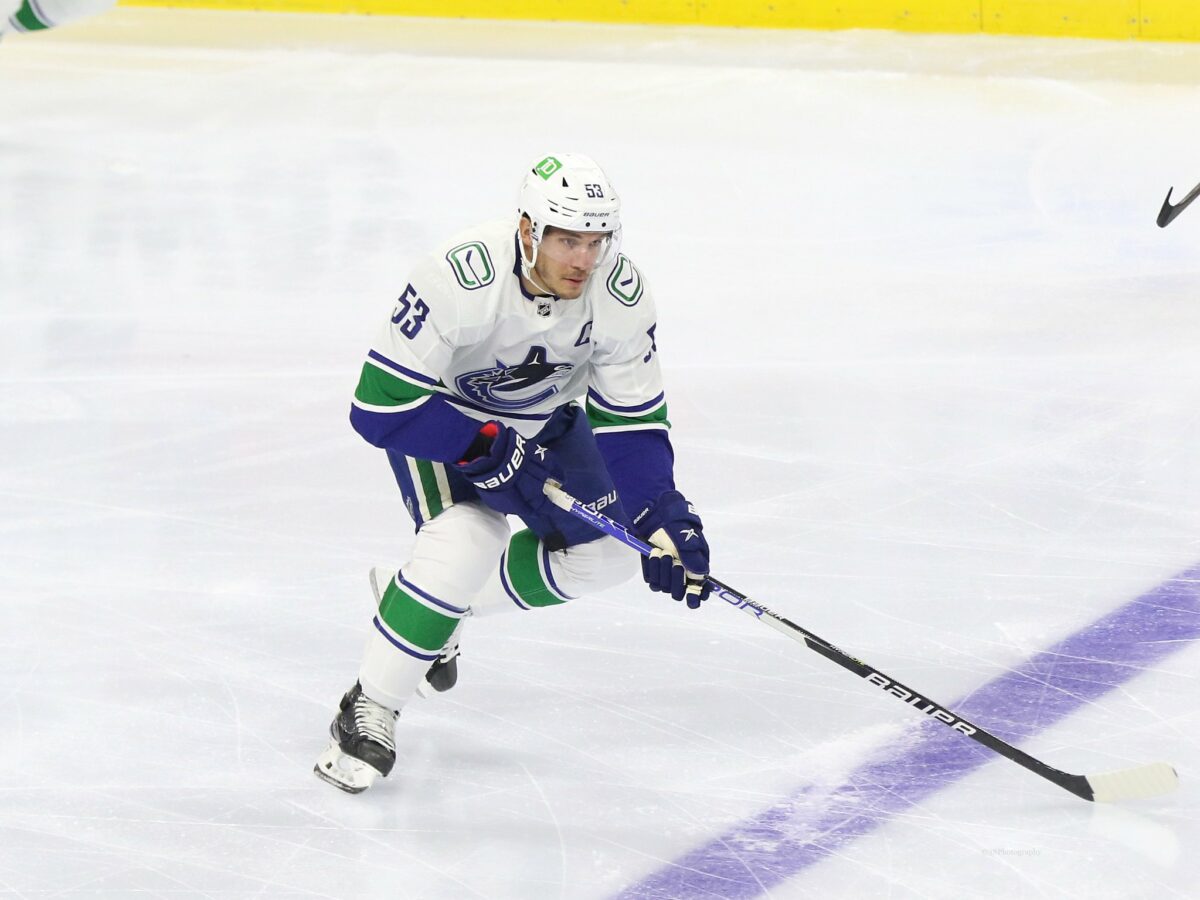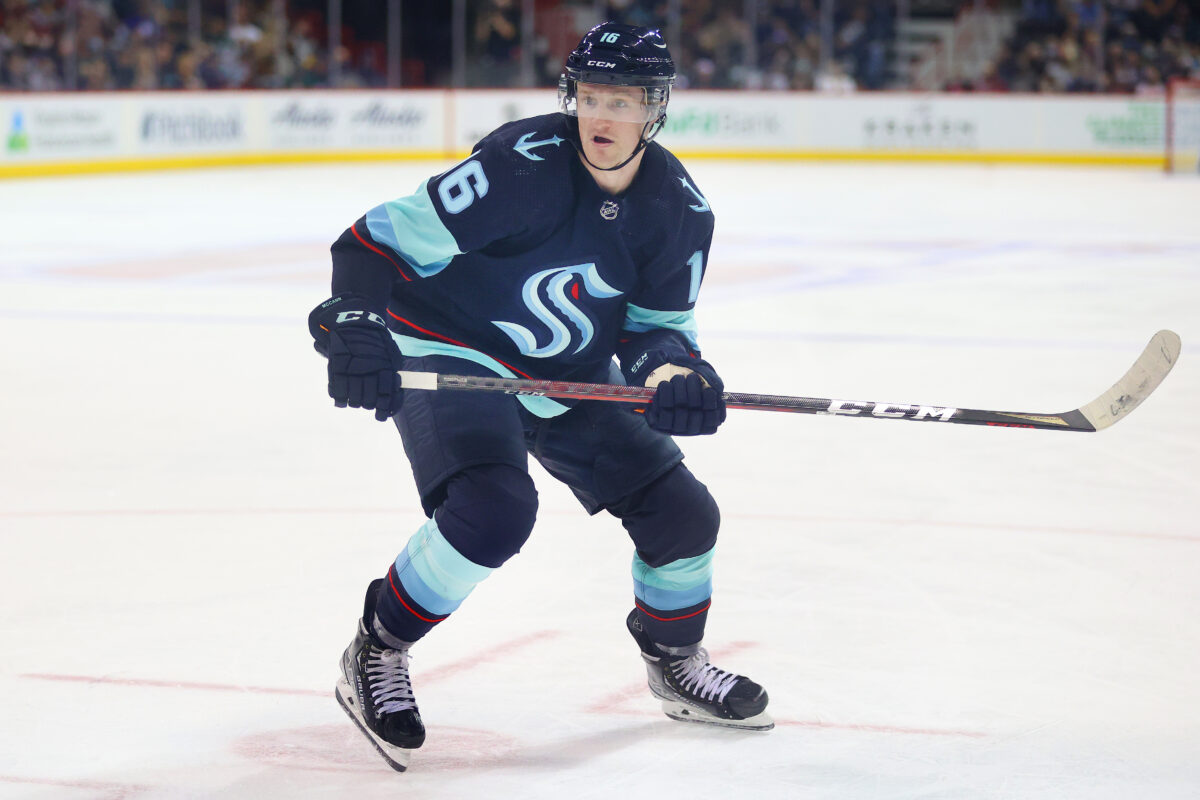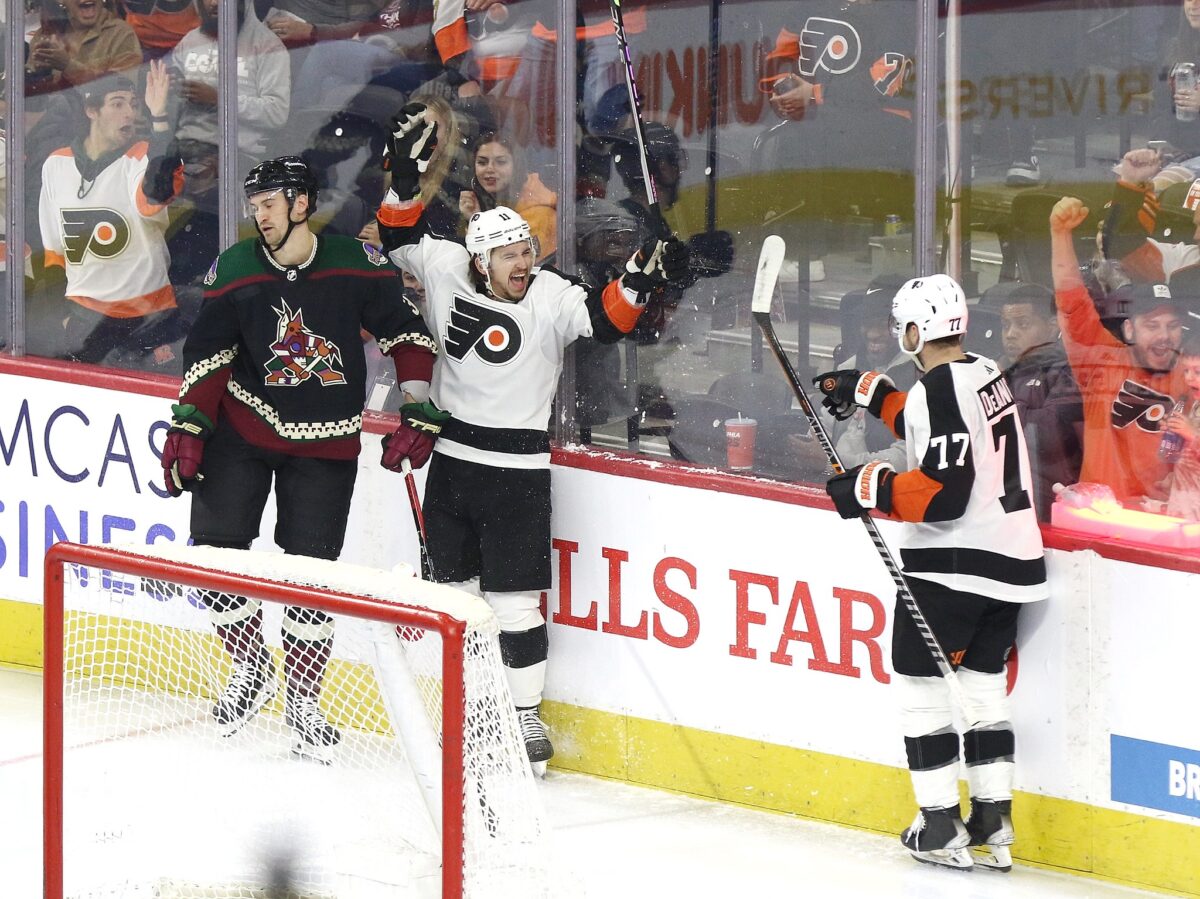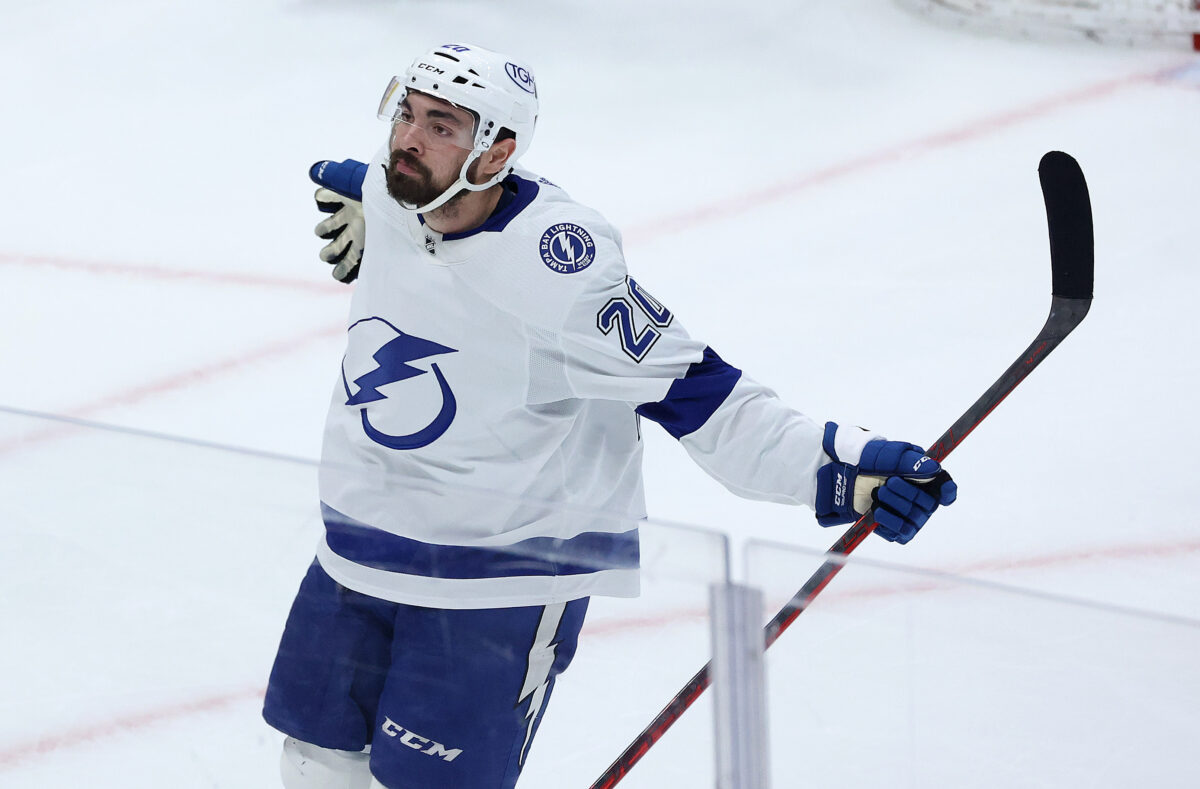As each of the NHL’s 32 teams has played in 40 or more games this season, it’s an appropriate time to take stock of the league and its players at the midway mark of the 2022-23 season. In particular, a number of unexpected names have rocketed atop the scoring leaderboards as the NHL is seeing an average of 3.17 goals scored per game this season. That represents the highest rate since the 1993-94 campaign (3.24) and a slight uptick on the 3.14 goals per game scored last season.
With those ballooning offensive totals come specific caveats, however, as certain players have produced at rates way out of line with their career rates halfway through the season. In some cases, players are following a natural developmental trajectory and breaking out, but several are coasting on unsustainable percentages that will naturally regress over time.
That’s not to say that they are bad players or will never score at such a level, but that they’re likely the beneficiaries of favourable puck luck, usage, or linemate deployment that masks their actual on-ice impact.
Related: Naming the NHL’s 2022-23 Underrated Analytics All-Stars
It’s these individuals that are the focus of this article, as I hope to highlight skaters whose surprising production likely isn’t a true reflection of their talent level. I’ve chosen to avoid players who, despite seeing a significant jump in scoring, are generating quality shots and scoring chances at an elite rate.
As a result, they should be able to sustain their elevated production over the long term. For example, this group includes players such as the current Norris Trophy frontrunner in Erik Karlsson, or Buffalo Sabres’ hulking sharpshooter in Tage Thompson.
With that context in mind, let’s dive into the five players – and five honourable mentions – most likely to see their scoring rates regress in the second half of the 2022-23 season.
Bo Horvat, Vancouver Canucks
2022-23 Stats: 41 Games Played (GP) – 29 Goals (G) – 17 Assists (A) – 46 Points (PTS) – 20:46 Average Time On Ice (ATOI)
Despite the Vancouver Canucks being embroiled in controversy after controversy this season, there is some light at the end of the tunnel. Captain Bo Horvat – a pending unrestricted free agent – is scoring at a 58-goal clip halfway through the season. His future with the organization is murky given that the Canucks lack an abundance of cap space in both the short- and long-term, and that rumours abound of rifts within the dressing room.
Beyond almost matching his previous career-high of 31 goals – set last season – in nearly half the number of games, Horvat’s shooting percentage (SH%) and chance generation suggest that his otherworldly finishing rate should cool off in the near future.

Horvat’s shot- and chance-generation at 5-on-5 are nowhere near what one would expect for a player contending for the Maurice Rocket Richard Trophy. Among qualified forwards (300 minutes played), he ranks 130th or worst in terms of shots, scoring chances, expected goals and high-danger chances per 60 minutes.
MoneyPuck estimates Horvat to have scored 14.4 more goals than expected in all situations, more than any other player this season including human supernova Connor McDavid (second with 14.2). Even though he’s a good shooter (he’s never dipped below 10 percent in a single season), converting chances at a higher rate than all of the NHL’s premier snipers is unsustainable for what he brings to the table.
Detractors point to the fact that Horvat could be incentivized by his lack of contract next season and the potential for a huge payday, so his increased production should be taken with a grain of salt. Although he is undoubtedly an impactful player at the most valuable position on the ice outside of the crease, the message for teams bidding on one of the 2023 trade deadline’s most desirable assets is as follows: buyer beware.
Jared McCann, Seattle Kraken
2022-23 Stats: 38 GP – 19 G – 8 A – 27 PTS – 15:07 ATOI
Among the biggest surprises from the first half of the season, the Seattle Kraken are on pace to make a nearly 48-point improvement over their 60-point debut performance in 2021-22. Beyond respectable goaltending and improved depth, career seasons from the likes of forward Jared McCann are the most significant reasons for their remarkable turnaround.
The 26-year-old forward has been of the NHL’s most underrated efficient scorers at 5-on-5, ranking 93rd among qualified forwards (300 minutes played) in goals per 60 minutes and 106th in points per 60 from 2019 to 2022. He also paced the Kraken in goals (27) and points (50) during their inaugural campaign, so his scoring outburst doesn’t come as much of a surprise.
Still, a 41-goal, 58-point pace this season might be difficult to maintain all season long. The Kraken rank first in the NHL in team SH% (12.3%), and every player is seeing his totals get an uplift as a result of the rising tides. Seattle’s roster doesn’t boast any truly elite finishers so don’t expect that to continue forever, and McCann’s individual underlying metrics suggest an incoming decline of some sort.

McCann’s all-situations SH% in 2022-23 (25.7%) is more than double his career mark of 10.5% prior to this season so that in and of itself is a dead giveaway for a dropoff. MoneyPuck also has him ranked fourth in the NHL with 11.6 goals scored above expected, sandwiched between Thompson and Jason Robertson on the cumulative leaderboard.
Further adding to the evidence for the argument of exercising caution is that McCann’s 5-on-5 SH% (30.1%) leads all qualified forwards this season. I don’t care if a player is a combination of Mike Bossy and Alexander Ovechkin, no one is scoring on a third of their shots over an extended period of time.
McCann is a useful player and gives the Kraken some much-needed offensive punch, as evidenced by his play last season. Still, expecting him to score at his current clip is foolish, so sell off your McCann stock before it’s too late.
Nick Suzuki, Montreal Canadiens
2022-23 Stats: 42 GP – 15 G – 20 A – 35 PTS – 22:13 ATOI
Even as I highlight Nick Suzuki as a likely candidate for regression, it’s arguable that the downturn has already begun. After scoring 12 goals and 24 points in his first 22 games of the season, the Canadiens’ captain has only scored 11 points in 20 games since December and tallied a mere three assists in five games since the start of 2023. Relatedly, his SH% in all situations went from 25.5 percent in the pre-December period to only 10 percent in games played post-Decemeber.
You may also like:
- Kings’ Akil Thomas Scores First-Career NHL Goal
- MacKinnon’s 3 Points Make Him 2nd Player to Hit 130 This Season
- Jets Clinch Playoff Spot After 5-2 Win Over Flames
- Panthers’ Coach Paul Maurice Moves Into 4th for All-Time Wins
- Flames’ MacKenzie Weegar Picks up 200th Career Point in Loss to Jets
Although some of that regression is simply due to percentages naturally correcting, Suzuki’s early finishing streak wasn’t backed up by impressive shot- or chance generation that could help cushion the blow.
| Statistic | Suzuki | Rank |
|---|---|---|
| Shots | 4.11 | 327 |
| Expected Goals | 0.38 | 337 |
| Scoring Chances | 3.42 | 338 |
| High-Danger Chances | 1.37 | 338 |
Before the Canadiens fanbase comes after me for disparaging one of their franchise cornerstones, I should note that I believe in his potential and two-way impact. The Suzuki-Cole Caufield duo will be one of the NHL’s best for years to come, and Suzuki will always generate most of his offensive value via playmaking.
That doesn’t take away from the fact that Suzuki is not at the level suggested by his hot start to the season (yet), but he’s a deserving All-Star Game representative for the franchise.
Travis Konecny, Philadelphia Flyers
2022-23 Stats: 36 GP – 24 G – 22 A – 46 PTS – 20:14 ATOI
With key contributors in Sean Couturier, Cam Atkinson, and Ryan Ellis out long-term through injury and many writing them off as favourites in the Connor Bedard sweepstakes, fans of the Philadelphia Flyers deserve some optimism. They’re a considerable longshot to make the playoffs, but their record of 17-18-7 is better than most predicted heading into the season.
Unfortunately, I’m here to temporarily rain on the parade. A shoutout to The Hockey Writers‘ beat writer for the Flyers, Colin Newby, who highlighted Travis Konecny – the Flyers’ All-Star Game representative – as a prime candidate for regression in the second half of the season.
The 25-year-old forward, who scored 61 points in 66 games in 2019-20, has almost singlehandedly dragged the Flyers to respectability with his scoring exploits this season. He’s one goal away from setting a new career high, and his rate of 1.28 points per game (P/G) represents a 55-goal, 105-point pace over 82 games. Konecny has already opened up a 10- and a 22-point lead on the Flyers’ second- (Kevin Hayes) and third- (Joel Farabee) leading scorers, despite playing in five and six fewer games respectively.

There’s no denying Konency’s offensive skill set, but his underlying numbers suggest that his output could revert back to his career norms in due course. First is his astronomical SH% (20.3 percent) which is easily his highest single-season mark, but it’s nearly double that of his career average of 11.5 percent prior to this season. No matter how significant of a developmental leap a player might take, scoring on a fifth of one’s shots is a feat that even the NHL’s most-skilled marksmen can’t accomplish over a full season.
According to MoneyPuck, Konecny has scored nine more goals than expected in all situations, which ranks eighth among all skaters this season. Players such as Auston Matthews and Alexander Ovechkin can, and regularly do, outperform their expected totals as a result of their elite finishing talent, but it’s very unlikely that Konecny has suddenly entered that goalscoring stratosphere.
Konecny is doing most of his damage at even strength (16 goals), owns top-75 rates of shots and scoring chances at 5-on-5, and is receiving the highest usage of his career, but that isn’t enough to combat the forces of regression.
That unfortunate statistical reality, combined with the Flyers potentially selling off James van Riemsdyk and Ivan Provorov at the trade deadline, point to an inevitable dip in scoring as the calibre of Konency’s supporting cast erodes as a result.
Nick Paul, Tampa Bay Lightning
2022-23 Stats: 40 GP – 15 G – 9 A – 24 PTS – 16:49 ATOI
The Tampa Bay Lightning always seem to acquire underappreciated gems at the trade deadline and polish them into even more impactful contributors in key situations. In 2022, that player was utility-man Nick Paul whose 14 points in 21 regular-season games and two-goal performance in Game 7 against the Toronto Maple Leafs helped take the Lightning to their third straight Stanley Cup Final.
The 6-foot-3 forward has picked up where he left off last season, with Paul already setting career-highs in goals and points and sitting fifth in team goalscoring halfway through the current campaign. His secondary offence is a significant reason why the Lightning can realistically envision a fourth straight trip to the Cup Final, but his production should drop off as the season progresses.

For one, Paul’s 20.8 percent shooting in all situations is the eighth-highest mark among qualified skaters and is more than double his previous best of 9.8 percent, which was set just last season. Further, his rates of shots (249th) and expected goals (178th) aren’t indicative of a player regularly getting the type of opportunities that would warrant a 31-goal pace over 82 games.
The capped-out Lightning will happily take any supplemental scoring that they can get but don’t expect Paul to keep firing at such a high clip, even as he counts Alex Killorn and Steven Stamkos as his most common linemates at 5-on-5. He’s also seeing slightly over a minute of powerplay time per game, but that type of usage isn’t enough to sustain his current level of production.
NHL’s Top Regression Candidates: Honourable Mentions
Here are five additional (dis)honourable mentions to round out a quasi-top 10 of players likely to see their boxscore totals take a dip in 2023:
- Brady Skjei, Carolina Hurricanes
- Jordan Kyrou, St. Louis Blues
- Alex Killorn, Tampa Bay Lightning
- Nico Sturm, San Jose Sharks
- Nic Dowd, Washington Capitals
Are there any other players that I missed whose hot starts should be highlighted? Let me know in the comments!
Data courtesy of AllThreeZones, Hockey Reference, MoneyPuck, and Natural Stat Trick. Statistics are accurate prior to games being played on Jan. 14.